PR
X
Keyword Search
▼キーワード検索
Comments
続日本100名城東北の…
New!
オジン0523さん
2025年版・岡山大学… New!
隠居人はせじぃさん
New!
隠居人はせじぃさん
【甥のステント挿入… Gママさん
Gママさん
ムベの実を開くコツ… noahnoahnoahさん
noahnoahnoahさん
エコハウスにようこそ ecologicianさん
2025年版・岡山大学…
 New!
隠居人はせじぃさん
New!
隠居人はせじぃさん【甥のステント挿入…
 Gママさん
Gママさんムベの実を開くコツ…
 noahnoahnoahさん
noahnoahnoahさんエコハウスにようこそ ecologicianさん
Calendar
カテゴリ: 海外旅行
「 Kylemore Abbey・カイルモア修道院
」に向かって湖岸を進む。
背後のドゥフルアハ山(Doughruagh)やティウェルブ・ベンズ(Twelve Bens)といった
険峻な山並みが、カイルモア修道院(Kylemore Abbey)の威厳をさらに際立てているように
感じたのであった。
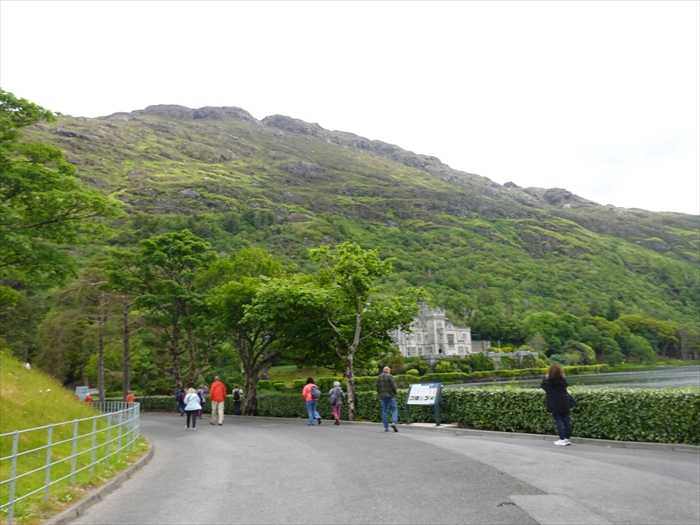
Pollacapall Lough・ポラカパル湖岸から「 Kylemore Abbey・カイルモア修道院 」を。
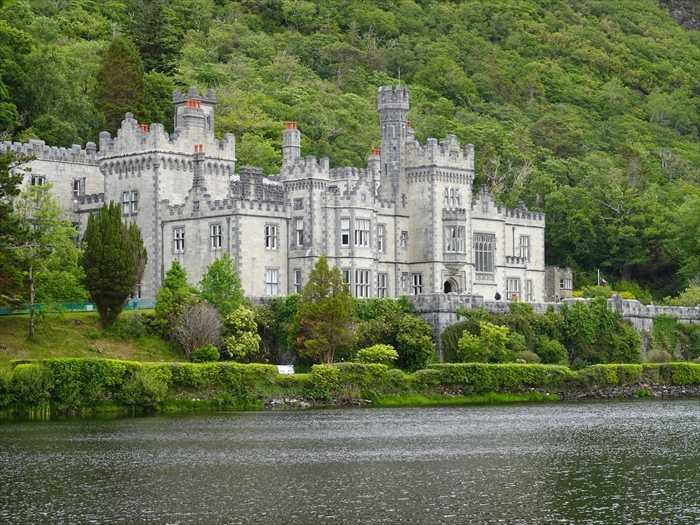
ズームして。
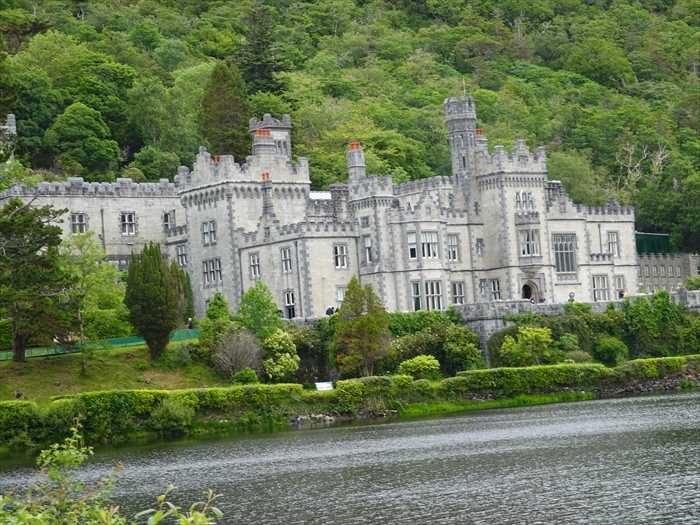
「 Lake Walk
Kylemore Abbey, formerly Kylemore Castle, is named after the Kylemore Valley.

赤レンガ造りの洞穴の如き場所が展示室に なっていた。
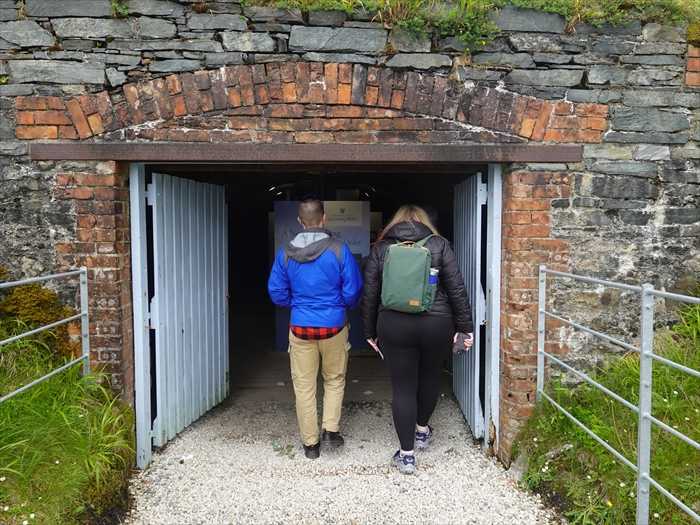
「ヴィクトリアン・ワールド」展示エリアのようであった。
A New Beginning for an Ancient Order
Kylemore Abbey
Our New Monastery
【 カイルモア修道院
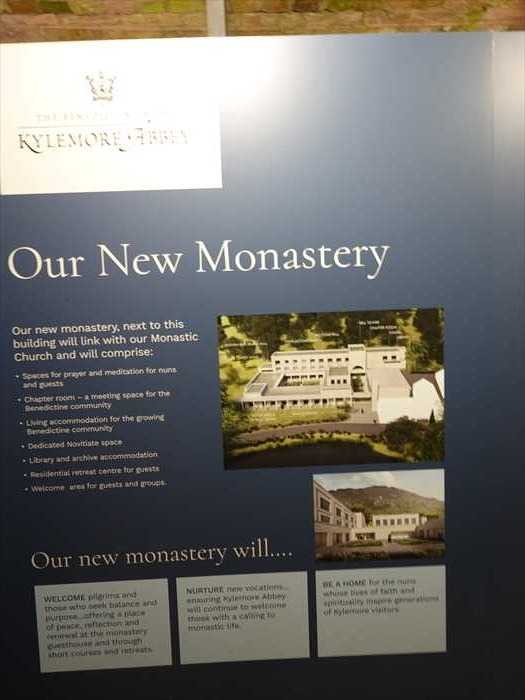
Monastic life at the heart of Kylemore
【カイルモアの中心にある修道生活
働き、祈りを捧げています。つまり、共同の修道院(共同生活の場)を持っていません。
しかし、新しい修道院が完成すれば、私たちの観想的な使命を果たすための場所がついに整い、
信仰と霊性の生きた伝統を分かち合うために、他の人々をカイルモアに招くことができる
ようになります。
ベネディクト会のもてなしの精神に則り、内省、平和、慰め、静けさを求める方々を
お迎えできることを、私たちは心から楽しみにしています。】
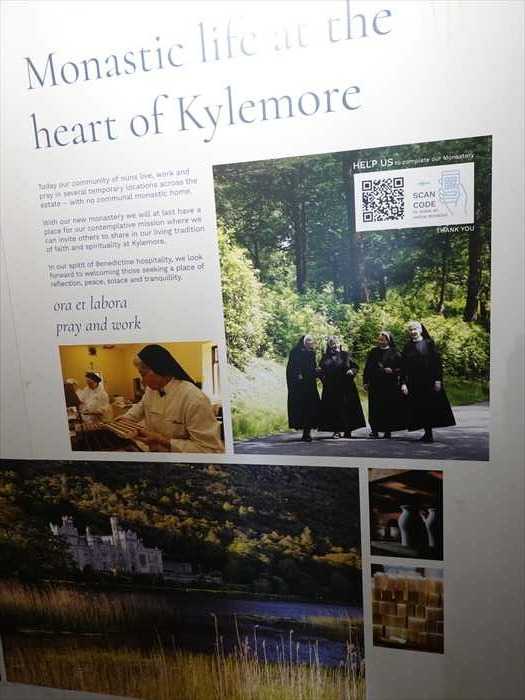
赤レンガ造りの洞窟内の展示室。

?????
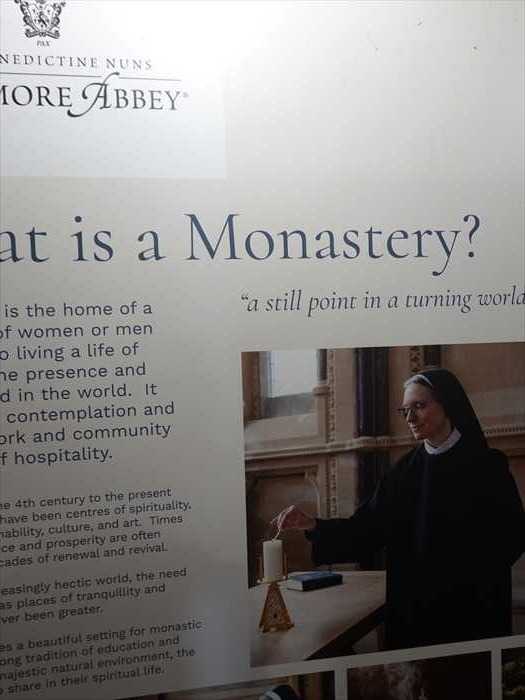
この女性は アイルランド第7代大統領(1990–1997)
メアリー・ロビンソン(Mary Robinson) 氏。
アイルランド史上初の女性大統領
その後、国連人権高等弁務官(1997–2002) としても国際的に活躍。

1990年代はカイルモアの敷地全体が活気にあふれた10年間で、1995年に当時の
アイルランド大統領メアリー・ロビンソンによって修復されたネオゴシック教会の
開館などの祝賀行事が行われた。
周囲にいるのは学生服姿の女子生徒たちで、おそらく修道院が女子寄宿学校
(Kylemore Abbey School)として機能していた時期の訪問時の様子 と。

History of the Benedictine Nuns
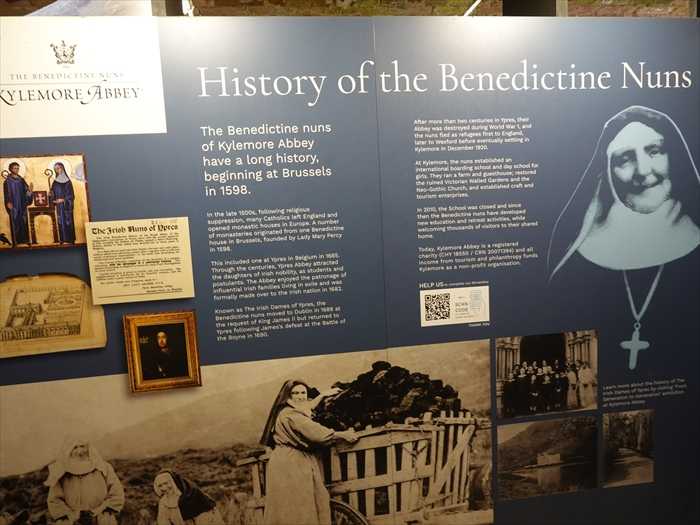
History of the Benedictine Nuns
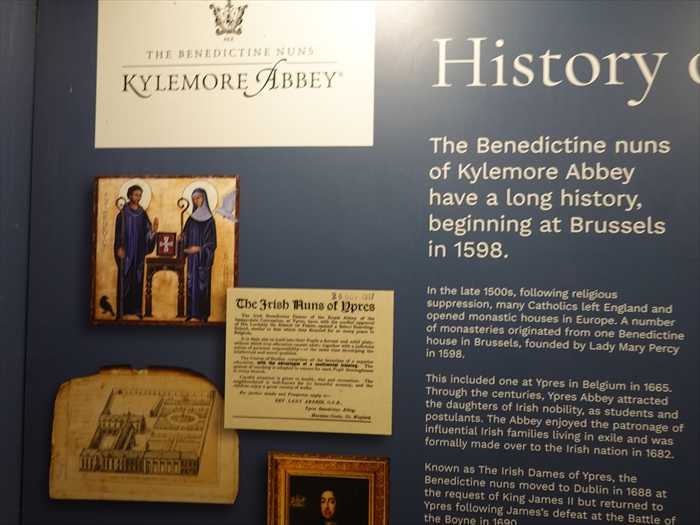

Kylemore Abbey Vistor Center手前から

大分近づいて来たのであった。
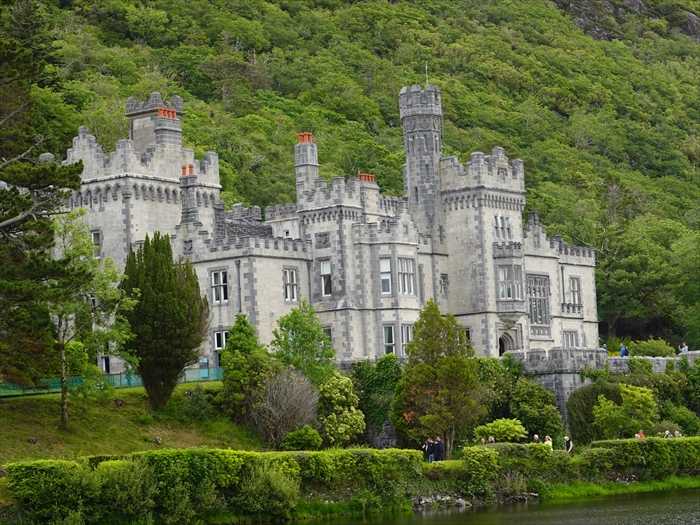
松の木であっただろうか!?
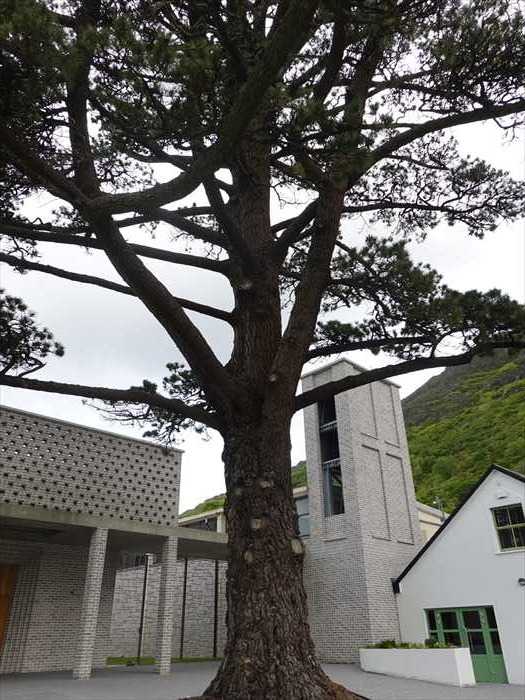
Kylemore Abbey Vistor Center入口。
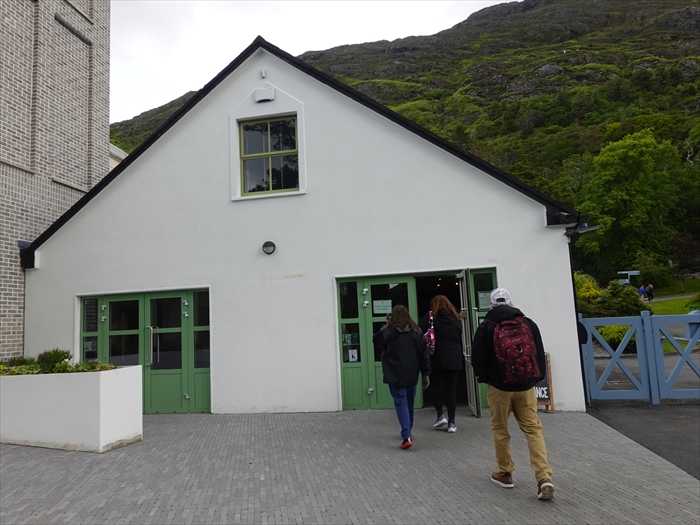
Pollacapall Lough・ポラカパル湖 を再び。

シャトルバス停近くにあった
White marble statue of Jesus Christ・白い大理石のキリスト像 。

ズームして。
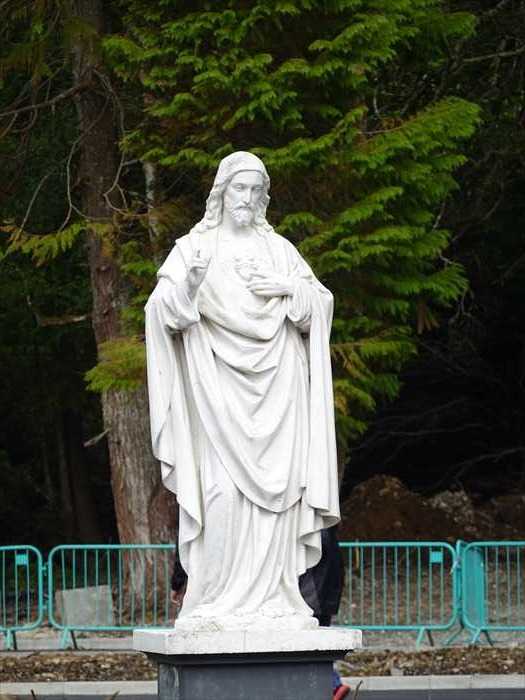
更に。

そして眼の前に カイルモア修道院(Kylemore Abbey)。
南向きに約43mもの幅広の正面をもつ建物は、ダルキー産御影石(グラニット)と
ボリナスロー産ライムストーンが用いられた荘厳な組み合わせ。

近づいて。
建物はメインブロック(2階建て)に加え、3階建て玄関部、オライル(張り出し)窓や
塔屋、西翼・東翼・コートヤード部などが連結された複雑な構造が特徴。

カイルモア修道院(Kylemore Abbey) の石塀、 Pollacapall Lough・ポラカパル湖、 そして
その奥の山々を見る。
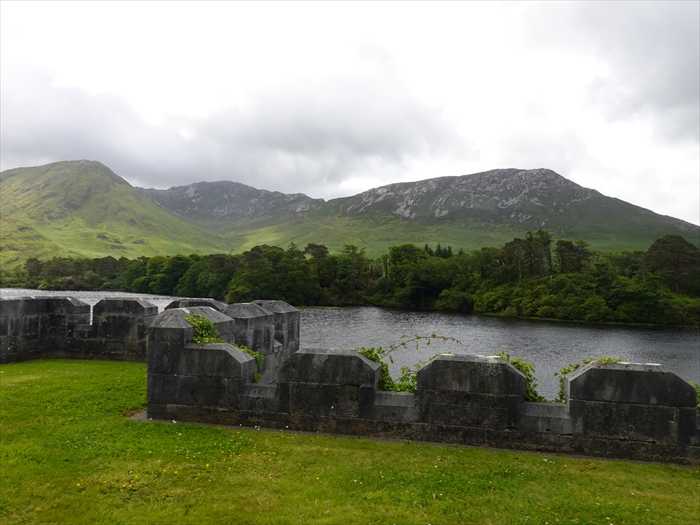
コナマーラ国立公園内の山々 をズームして。
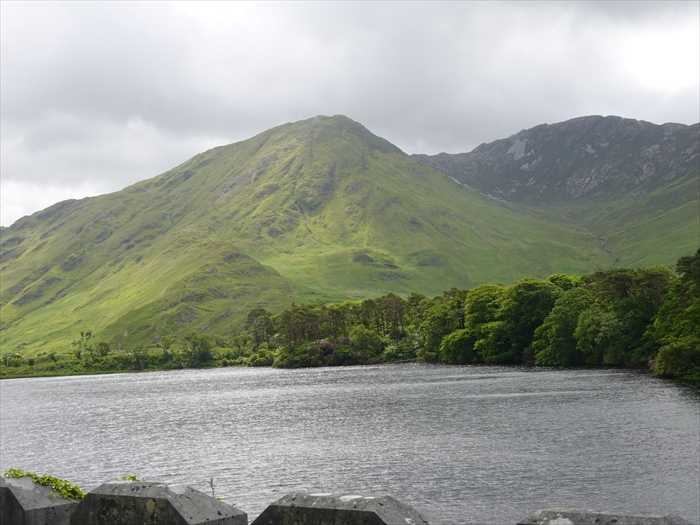
中央のみ3階建て。

3階部をズームして。

Pollacapall Lough・ポラカパル湖の東側 を見る。
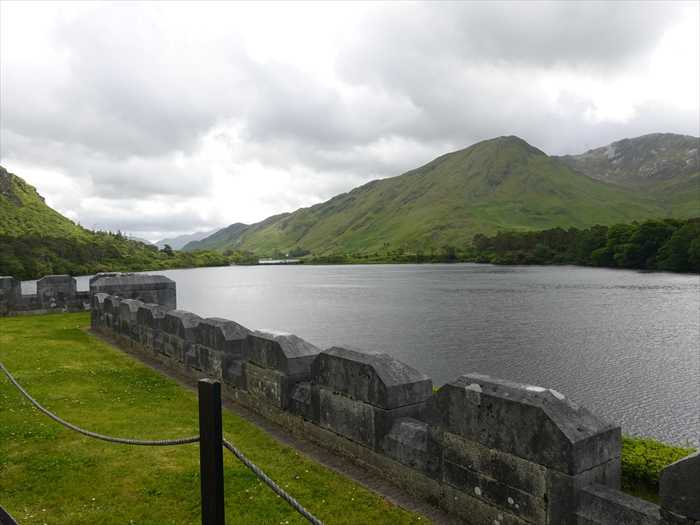
再び中央部を。

・・・もどる・・・
・・・つづく・・・
背後のドゥフルアハ山(Doughruagh)やティウェルブ・ベンズ(Twelve Bens)といった
険峻な山並みが、カイルモア修道院(Kylemore Abbey)の威厳をさらに際立てているように
感じたのであった。

Pollacapall Lough・ポラカパル湖岸から「 Kylemore Abbey・カイルモア修道院 」を。

ズームして。

「 Lake Walk
Kylemore Abbey, formerly Kylemore Castle, is named after the Kylemore Valley.
The original estate stretched over 12 townlands. Today it spans 5: Lettershask, Pollacappul, Addergoole, Curraunvuggaun, and Mweelin.
A townland, like a fountain, is an old geographical land division still in use. The name is a valuable part of our Irish heritage, referring to a geographical feature, a historical event,
or even a local legend of the area.
Castle townland names were standardized and anglicized in the 19th century by the British Ordnance Survey.
The townland of Kylemore, from Coill Mór translating to Big Wood, was never part of
the estate. Mitchell Henry adopted the name and reforested the valley.」
【 湖畔の小道
カイルモア修道院(旧名:カイルモア城)の名は、カイルモア渓谷に由来しています。
A townland, like a fountain, is an old geographical land division still in use. The name is a valuable part of our Irish heritage, referring to a geographical feature, a historical event,
or even a local legend of the area.
Castle townland names were standardized and anglicized in the 19th century by the British Ordnance Survey.
The townland of Kylemore, from Coill Mór translating to Big Wood, was never part of
the estate. Mitchell Henry adopted the name and reforested the valley.」
【 湖畔の小道
カイルモア修道院(旧名:カイルモア城)の名は、カイルモア渓谷に由来しています。
元々の領地は12の「タウンランド(小行政区)」にまたがっていました。現在の領地は、
レタシャスク、ポラカパル、アダーグール、クランヴァガン、そしてムウィーリンの5地区に
及びます。
レタシャスク、ポラカパル、アダーグール、クランヴァガン、そしてムウィーリンの5地区に
及びます。
「タウンランド」は、泉のように古くから使われてきたアイルランドの地理的区分で、今も
使用されています。その名称は、地形的特徴、歴史的事件、あるいは地域の伝説など、
アイルランドの文化遺産を今に伝える貴重な要素です。
使用されています。その名称は、地形的特徴、歴史的事件、あるいは地域の伝説など、
アイルランドの文化遺産を今に伝える貴重な要素です。
19世紀、これらの地名はイギリス軍測量部によって標準化・英語化されました。
なお、「カイルモア」という地名(原義はCoill Mór=大きな森)は、実はこの領地の一部では
ありませんでした。ミッチェル・ヘンリーがこの名を採用し、この渓谷に再び森を育てたのです。】
ありませんでした。ミッチェル・ヘンリーがこの名を採用し、この渓谷に再び森を育てたのです。】

赤レンガ造りの洞穴の如き場所が展示室に なっていた。

「ヴィクトリアン・ワールド」展示エリアのようであった。
A New Beginning for an Ancient Order
The Benedictine nuns welcome you to their homeat Kylemore Abbey.
Since 1920 our community of monastic women has lived and prayed here according
to the Rule of St.Benedict,while preserving the beauty and heritage of this place、
educating generations of young women, welcoming visitors and creating employment.
to the Rule of St.Benedict,while preserving the beauty and heritage of this place、
educating generations of young women, welcoming visitors and creating employment.
Today,after 100 years at Kylemore we have embarked on the most important and
ambitious building project in our 400-year history:
・a new monastery and purpose-built home for the growing community of
Benedictine nuns
・residential guest accommodation for pilgrisms and visitors to share the sacred of
their lives through short courses and retreats.
【 古の修道制に新たな始まり
ambitious building project in our 400-year history:
・a new monastery and purpose-built home for the growing community of
Benedictine nuns
・residential guest accommodation for pilgrisms and visitors to share the sacred of
their lives through short courses and retreats.
【 古の修道制に新たな始まり
ベネディクト会修道女たちは、カイルモア修道院へようこそと皆さまをお迎えします。
1920年より、私たち修道女の共同体はこの地で聖ベネディクトの戒律に従い、祈りとともに
生活を営んできました。この場所の美しさと遺産を守りながら、
若い女性たちを教育し、世界中からの訪問者を歓迎し、地元に雇用を生み出してきました。
生活を営んできました。この場所の美しさと遺産を守りながら、
若い女性たちを教育し、世界中からの訪問者を歓迎し、地元に雇用を生み出してきました。
そして現在、カイルモアでの100年を経て、私たちは400年に及ぶ修道会の歴史の中でも
最も重要で、かつ野心的な建築プロジェクトに取り組んでいます。

最も重要で、かつ野心的な建築プロジェクトに取り組んでいます。
・成長を続けるベネディクト会修道女共同体のための、新しい修道院および専用の住まいの建設
・巡礼者や訪問者のための宿泊施設を整備し、短期講座やリトリート(霊的静修)を通じて
彼らの人生における“聖なるもの”を分かち合う機会を提供すること】
彼らの人生における“聖なるもの”を分かち合う機会を提供すること】

Kylemore Abbey
Our New Monastery
Our new monastery, next to this building will link with link with our Monastic
Church and will comprise:
・Spaces for prayer and meditation for nuns and guests
・Chapter rooomーa meeting space for the Benedictine community
・Chapter rooomーa meeting space for the Benedictine community
・Living accommodation for the growing Benedictine community
・Dedicated Novitiate space
・Library and archive accommodation
・Residential retreat centre for guests
・Residential retreat centre for guests
・Welcome area for guests and groups.
【 カイルモア修道院
私たちの新しい修道院
この建物の隣に建設される新しい修道院は、私たちの修道会教会(Monastic Church)と
つながり、以下の施設を備えます:
つながり、以下の施設を備えます:
・修道女とゲストのための祈りと瞑想の空間
・チャプタールーム(ベネディクト会の共同体が集まる会議の場)
・チャプタールーム(ベネディクト会の共同体が集まる会議の場)
・拡大するベネディクト会修道女共同体のための居住スペース
・修練者(ノビシャ)専用のスペース
・図書室および文書保管室
・ゲストのための宿泊型リトリートセンター
・ゲストおよび団体のためのウェルカムエリア】

Monastic life at the heart of Kylemore
Today our community of nuns live,work and pray in several temporary locations across
the estateーwith no communal monastic home.
the estateーwith no communal monastic home.
With our new monastery we will at last have a place for our contemplative mission where
we can invite others to share in our living tradition of faith and spirituality at Kylemore.
we can invite others to share in our living tradition of faith and spirituality at Kylemore.
In our spitit of Benedictine hospitality, we look forward to welcoming those seeking a place
of reflection, peace, solace and tranquillity.
of reflection, peace, solace and tranquillity.
【カイルモアの中心にある修道生活
働き、祈りを捧げています。つまり、共同の修道院(共同生活の場)を持っていません。
しかし、新しい修道院が完成すれば、私たちの観想的な使命を果たすための場所がついに整い、
信仰と霊性の生きた伝統を分かち合うために、他の人々をカイルモアに招くことができる
ようになります。
ベネディクト会のもてなしの精神に則り、内省、平和、慰め、静けさを求める方々を
お迎えできることを、私たちは心から楽しみにしています。】

赤レンガ造りの洞窟内の展示室。

?????

この女性は アイルランド第7代大統領(1990–1997)
メアリー・ロビンソン(Mary Robinson) 氏。
アイルランド史上初の女性大統領
その後、国連人権高等弁務官(1997–2002) としても国際的に活躍。

1990年代はカイルモアの敷地全体が活気にあふれた10年間で、1995年に当時の
アイルランド大統領メアリー・ロビンソンによって修復されたネオゴシック教会の
開館などの祝賀行事が行われた。
周囲にいるのは学生服姿の女子生徒たちで、おそらく修道院が女子寄宿学校
(Kylemore Abbey School)として機能していた時期の訪問時の様子 と。

History of the Benedictine Nuns

History of the Benedictine Nuns
The Benedictine nuns of Kylemore Abbey have a long history,
beginning at Brussels in 1598.
In the late 1500S , following religious suppression, many Catholics left England and
opened monastic houses in Europe、A number of monasteries originated from one
Benedictine house in BrusseIs, founded by Lady Mary Percy in 1598.
Benedictine house in BrusseIs, founded by Lady Mary Percy in 1598.
This included one at Ypres in Belgium in 1665.Through the centuries, Ypres Abbey
attracted the daughters of lrish nobility, as students and postulants、The Abbey enjoyed
the patronage of influential Irish families living in exile and wa formally made over to
the lrish nation in 1682.
Known as The lrish Dames Of Ypres, the Benedictine nuns moved to Dublin in 1688 at
attracted the daughters of lrish nobility, as students and postulants、The Abbey enjoyed
the patronage of influential Irish families living in exile and wa formally made over to
the lrish nation in 1682.
Known as The lrish Dames Of Ypres, the Benedictine nuns moved to Dublin in 1688 at
the request of King James Ⅱ but returned to Ypres following James's defeat at the
BattIe of the Boyne in 1690.
【 ベネディクト会修道女の歴史
BattIe of the Boyne in 1690.
【 ベネディクト会修道女の歴史
カイルモア修道院のベネディクト会修道女たちの歴史は、1598年にブリュッセルで始まりました。
1500年代後半、宗教弾圧を受けて多くのカトリック教徒がイングランドを離れ、ヨーロッパ
各地に修道院を設立しました。その中のいくつかの修道院は、1598年にレディ・メアリー・
パーシーによってブリュッセルに創設されたベネディクト会修道院を起源としています。
各地に修道院を設立しました。その中のいくつかの修道院は、1598年にレディ・メアリー・
パーシーによってブリュッセルに創設されたベネディクト会修道院を起源としています。
1665年にはベルギーのイーペルにも修道院が設立されました。何世紀にもわたって、
このイーペル修道院は、アイルランドの貴族の娘たちが学生や志願者(修道女を志す者)
として集まる場となりました。修道院は亡命中の有力なアイルランド人家族の支援を受け、
1682年には正式にアイルランド国家に帰属する修道院とされました。
このイーペル修道院は、アイルランドの貴族の娘たちが学生や志願者(修道女を志す者)
として集まる場となりました。修道院は亡命中の有力なアイルランド人家族の支援を受け、
1682年には正式にアイルランド国家に帰属する修道院とされました。
「イーペルのアイルランド人修道女たち(The Irish Dames of Ypres)」として知られるこの
修道女たちは、1688年、国王ジェームズ2世の要請によりダブリンへ移転しましたが、
1690年のボイン川の戦いでジェームズが敗れた後、再びイーペルに戻ることとなりました。】
修道女たちは、1688年、国王ジェームズ2世の要請によりダブリンへ移転しましたが、
1690年のボイン川の戦いでジェームズが敗れた後、再びイーペルに戻ることとなりました。】

After more than two centuries in Ypres, their Abbey was destroyed during world war 1 ,
and the nuns fled as refugees first to EngIand,
and the nuns fled as refugees first to EngIand,
later to Wexford before eventually settling in Kylemore in December 1920.
At Kylemore, the nuns established an international boarding school and day school for
girls. They ran a farm and guesthouse; restored the ruined Victorian Walled Gardens
and theNeo-Gothic Church, and established craft and tourism enterprises.
girls. They ran a farm and guesthouse; restored the ruined Victorian Walled Gardens
and theNeo-Gothic Church, and established craft and tourism enterprises.
In 2010 , the School was closed and since then the Benedictine nuns have developed
welcoming thousands of visitors to their shared home.
Today, Kylemore Abbey is a registered charity (CHY 18550 / CRN 20071394 ) and all
income from tourism and philanthropy funds Kylemore as a non-profit organisation.
【第一次世界大戦でイーペルの修道院が破壊され、修道女たちは難民としてイングランドへ
逃れました。その後ウェックスフォードを経て、最終的に1920年12月、カイルモアへ移り
住みました。
カイルモアにおいて修道女たちは、国際的な女子の寄宿学校および通学制の学校を設立しました。
また、農場やゲストハウスの運営、荒廃していたヴィクトリア様式の囲い壁付き庭園や
ネオ・ゴシック様式の教会の修復、さらには手工芸や観光関連事業の立ち上げも行いました。
2010年には学校を閉鎖し、それ以降は修道院を訪れる多くの来訪者を受け入れる活動に力を
注いでいます。
【第一次世界大戦でイーペルの修道院が破壊され、修道女たちは難民としてイングランドへ
逃れました。その後ウェックスフォードを経て、最終的に1920年12月、カイルモアへ移り
住みました。
カイルモアにおいて修道女たちは、国際的な女子の寄宿学校および通学制の学校を設立しました。
また、農場やゲストハウスの運営、荒廃していたヴィクトリア様式の囲い壁付き庭園や
ネオ・ゴシック様式の教会の修復、さらには手工芸や観光関連事業の立ち上げも行いました。
2010年には学校を閉鎖し、それ以降は修道院を訪れる多くの来訪者を受け入れる活動に力を
注いでいます。
現在、カイルモア修道院は登録慈善団体(CHY 18550 / CRN 20071394)となっており、
観光や寄付による収益はすべて、営利を目的としない運営のために用いられています。】
観光や寄付による収益はすべて、営利を目的としない運営のために用いられています。】

Kylemore Abbey Vistor Center手前から

大分近づいて来たのであった。

松の木であっただろうか!?

Kylemore Abbey Vistor Center入口。

Pollacapall Lough・ポラカパル湖 を再び。

シャトルバス停近くにあった
White marble statue of Jesus Christ・白い大理石のキリスト像 。

ズームして。

更に。

そして眼の前に カイルモア修道院(Kylemore Abbey)。
南向きに約43mもの幅広の正面をもつ建物は、ダルキー産御影石(グラニット)と
ボリナスロー産ライムストーンが用いられた荘厳な組み合わせ。

近づいて。
建物はメインブロック(2階建て)に加え、3階建て玄関部、オライル(張り出し)窓や
塔屋、西翼・東翼・コートヤード部などが連結された複雑な構造が特徴。

カイルモア修道院(Kylemore Abbey) の石塀、 Pollacapall Lough・ポラカパル湖、 そして
その奥の山々を見る。

コナマーラ国立公園内の山々 をズームして。

中央のみ3階建て。

3階部をズームして。

Pollacapall Lough・ポラカパル湖の東側 を見る。

再び中央部を。

・・・もどる・・・
・・・つづく・・・
お気に入りの記事を「いいね!」で応援しよう
【毎日開催】
15記事にいいね!で1ポイント
10秒滞在
いいね!
--
/
--
© Rakuten Group, Inc.










